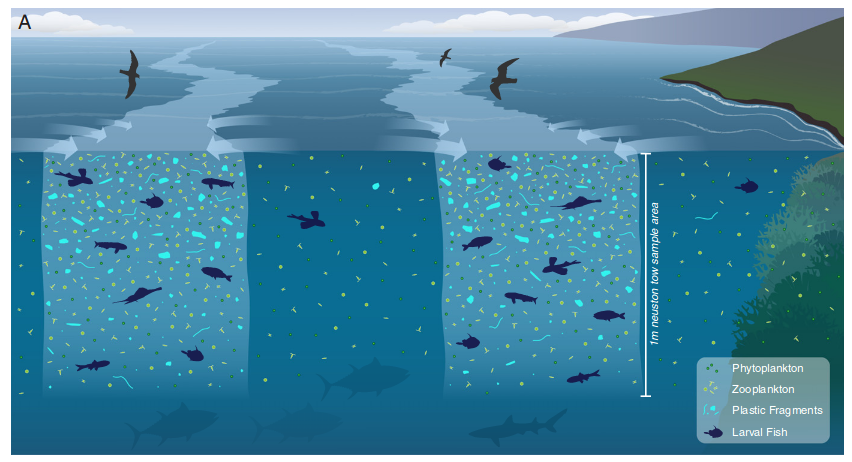Table of Contents
Group 4
<html><font size=6 face=“Arial”>An
embarassment of plastics</font></html>
Wiki site of the practical exercise of the IX Southern-Summer School on Mathematical Biology.
Here you will find the exercise assignment and the group's products.
If you are a group member login to edit this page, create new pages from it, and upload files.
Introduction
Many marine fish begin their life at ocean surface, where they live for days to weeks, feeding mainly from zooplankton until its development is complete. The availability of such resource is therefore fundamental for these marine fish species' survival.
Surface slicks are meandering lines of convergence on the ocean surface, usually formed by wind and internal waves, that accumulate zooplankton and other microorganisms, becoming an attractive spot for larval fish to feed when compared with other ocean surface areas. As the distance between surface slicks are of the order of 1 kilometer, larger larval fish, with increased swimming competency, are able to migrate to/from surface slicks in order to capitalize on concentrated prey resources, whilst other less competent small fish are simply dragged in and out of these regions.
The mean size of fishes in slicks was found to be almost 30% larger than in other surface areas, probably because some larger, more developed, larval fish are able to detect the accumulation of resources and indeed travel from slick to slick, whilst other large larval fish cannot detect said accumulation or choose not to travel to slicks, feeding less and hence presenting a smaller mean size. Also, since smaller, less developed, larval fish are dragged in and out of slicks, some can remain feeding in it and achieve larger sizes than the ones that don't.
However, these surface slicks also tend to accumulate micro plastics that are often mistaken as food by larval fish. Currently slicks contain a ratio of about 7:1 of plastics:resource, which is much larger than the ratio of 1:2 found in other surface areas. Consuming plastics may have multiple negative effects in fish growth, posing a threat to some species as its main nurseries become plastic deposits.
Assignment
Propose a mathematical model for the fish population in both habitats, that is, surface slicks and other surface areas, incorporating the effects of resource and plastic accumulation in slicks and also the harmful effects plastics may cause in fish population.
Suggested questions and tips
- Is there any advantage in avoiding surface slicks due to plastic accumulation? Would it make surface slicks a refuge for zooplankton? If so, could it be reversed once the ratio of plastics to zooplankton become small?
- Could larval fish maintain plastic levels in surface slicks under control due to their accidental consumption? Remember they take it away once they mature.
- We suggest you to focus on larger larval fishes, as they can actively search, or not, for slicks, and may spend time foraging in and out of it.
Further well-grounded questions from the group are welcome.
References
J.M. Gove et al. Prey-size plastics are invading larval fish nurseries, PNAS, 2019, https://www.pnas.org/content/pnas/116/48/24143.full.pdf

